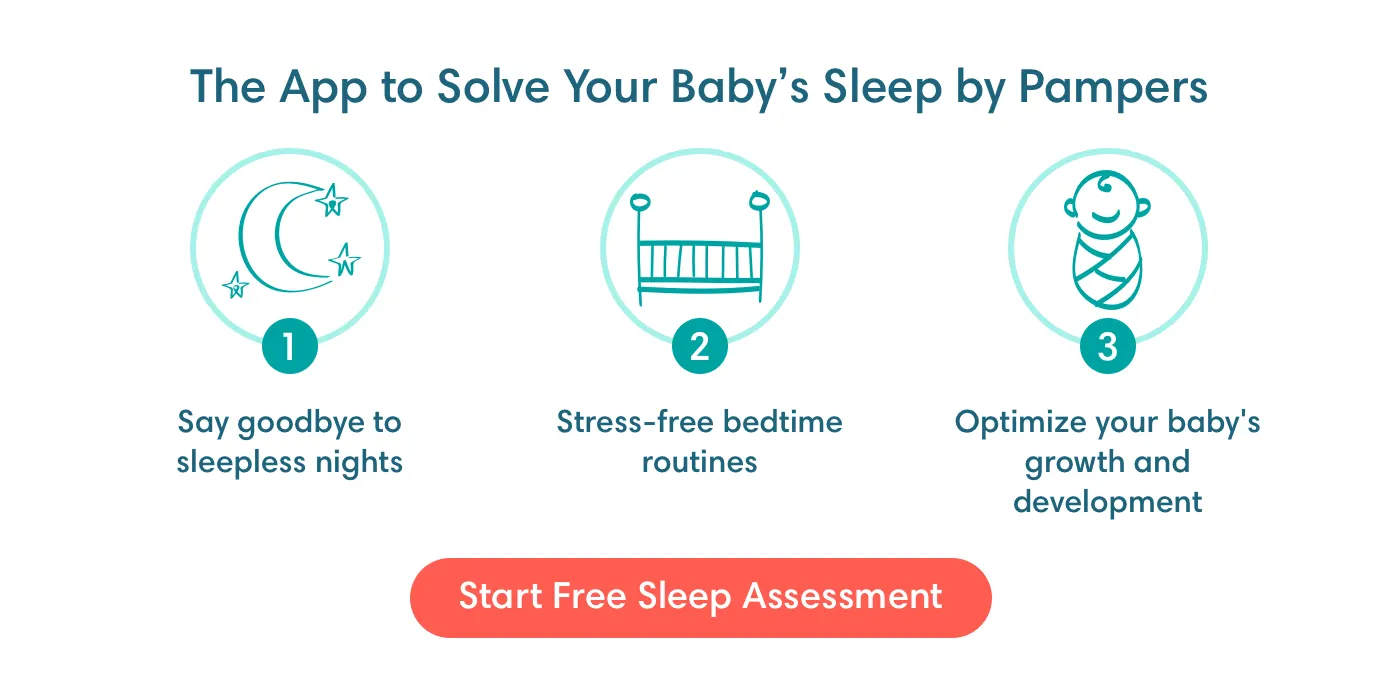All About the Cry-It-Out Method to Sleep Train Your Baby
As you prepare to embark on the sleep training journey with your little one, you're likely on the lookout for the most suitable strategy. You might've heard chatter amongst other parents about the cry-it-out (CIO) method, but does it align with your child's needs and your parenting style? We’ll provide you with all the details on the cry-it-out method to help you make your decision. There's a wealth of sleep-training methods out there, and the cry-it-out method—also referred to as the extinction method—is merely one of them.
What Is the Cry-It-Out (CIO) Sleep Training Method for Babies?
The cry-it-out (CIO) method is just as it sounds: letting your baby cry it out during sleep training. The method works because babies need to learn how to fall asleep, just like they learn other skills, such as rolling over, crawling, and walking. And to learn this ability, your little one needs a safe space and enough time to practice. As a parent, it might help to remember this tidbit, stay patient through the process, and know it will inevitably take time for your baby to master the skill.
The CIO (cry-it-out or extinction) sleep training method is one way to give your baby the necessary space to learn this skill. This method has you meet all your baby’s needs (feeding, a clean diaper, etc.) before placing them down to sleep while drowsy yet still awake. At which point you leave the room, and your baby is left to self-settle.
CIO is a non-parental involvement method, so essentially, you don't enter the room once you've put your baby down (of course, knowing you’ve met all their needs). If your baby is used to being rocked to sleep or fed to sleep, you can expect this change in approach will be met with some protesting. However, they will eventually fall asleep within a few nights and will have learned to self-soothe.
Tip It's also important to keep in mind that habit change is hard, and crying is a natural and normal response for babies and children of all ages. No matter what sleep-training approach or method you take, it’s likely to be met with some level of protest and crying. |
If you’re just starting to think about sleep training and don’t know where to begin, you can take this free sleep assessment and get a personalized sleep plan to address your baby’s sleep challenges.
CIO, Ferber, Pick-Up/Put-Down Methods: What’s the Difference?
We can classify sleep-training methods on a sliding scale from no-parental involvement (like CIO) to high parental involvement. This table gives you an idea of how to compare some of the different methods, but this is just three in a range of options to help your child learn to fall asleep:
| Sleep-Training Method | CIO | Ferber | Pick-Up/Put-Down |
|---|---|---|---|
| Parental Involvement | None | Moderate | High |
| Description | Allow your baby the space to self-soothe. | Uses timed checks to provide a brief reassurance, where the intervals between visits increase each time. | Pick your baby up every time they protest, placing them back in the crib once they’ve calmed down. |
| Best For | CIO works best for babies who are more resistant to change or parents who are looking for the fastest solution to sleep training. | The Ferber Method is best for easy-going babies who go with the flow and parents who can be consistent in waiting out the necessary intervals. | Parents who want to ease their way into habit change with little protesting might find the Pick-up/Put-down method to be the best. |
| Considerations | Protesting can last a long time (an hour or more) for the first night or two, but this method does work the fastest. You’ll see results in a couple of days, and it’s the easiest method for your baby to understand, as the message is consistent and clear for all sleep. | IIf crying/protesting escalates when you enter the room, this may not be the best method for your baby. You could switch to the CIO method in this case. Ferber will take a little longer than the cry-it-out method, and it doesn’t work well for naps (CIO tends to be better for napping). | If crying/protesting escalates when you enter the room, this might also not be the best method for your baby. You could switch to Ferber/CIO. This method takes longer for your baby to learn how to self-soothe, as they have less time to practice. |
| How long it takes* | 3-4 days for initial results | 7-10 days for initial results | 14-21+ days for initial results |
*Every baby is different, so it can be hard to put a time on each method. It also depends on how consistently you have applied the sleep-training method. Keep in mind that every time you “cave in” to your baby’s cries, you essentially return to the start.
When Can You Start and Stop the Cry-It-Out Method?
A common question from parents is, “When can you let a baby cry it out?” Pediatricians recommend you don’t start sleep training in general, including using the cry-it-out method, until your baby has reached the age of 12 weeks and a weight of 12 pounds.
Some parents assume sleep training should come much earlier and ask the question, how long should you let a newborn baby cry? The answer is never, and that’s because during the first 12-16 weeks of life, your baby’s circadian rhythm is maturing, and they are adjusting to life outside of the womb while learning the difference between night and day. This means their sleep is very disorganized and sleep training won’t work well, and that’s why you shouldn’t let a newborn cry it out.
Tip Regardless of when you start sleep training, it’s always a good idea to get the green light from your pediatrician first. |
As a sleep consultant, I find that babies are mostly ready, and you are most likely to succeed when you start sleep training from 16 weeks of age. However, you can start with healthy sleep fundamentals from day one, which include:
Setting up the sleep space with blackout shades, a sound machine, and having the room 68 to 72°F
Delivering a consistent bedtime routine
Placing baby down when drowsy but still awake
Using sleepy cues to know when your baby is tired and ready to sleep
Is My Baby Ready for Sleep Training with the CIO Method?
Remember that every baby and situation is different, so you might have to adjust your timeline a bit according to your little one’s specific needs. You might notice one or more of the following signs when your baby is ready for sleep training:
Crying, being fussy, or appearing overtired in the evenings
Difficulty falling asleep at night and fighting bedtime
Waking frequently at night and needing help to get back to sleep
Waking too early in the morning
Inconsistent naps or taking extra short naps.
Remember, the goal of sleep training is for your little one to learn to fall asleep on their own. Once they've accomplished this, they will no longer protest at bedtime or wake crying in the night; they will simply roll over and go to sleep.
As you select the right approach to sleep training for your family, use your best judgment to decide what will work for you. But remember, if your little one doesn’t seem to be responding to your chosen approach, you can always consider trying a different method.
Tip It’s always easier to move from a higher parental involvement method to a lower parental involvement method rather than the other way around. |
And as you prepare for sleep training, check out this video from Mandy, our Pediatric Sleep Coach, so you are set up for success:
How to Do the Cry-It-Out (CIO) or Extinction Sleep Training Method
Preparing to sleep train is almost as essential as consistently delivering the sleep-training method itself. So, before you actually start the CIO method, there are a few important steps you should take:
Determine your timeline. First, you’ll want to choose when to start the CIO method. Discuss the approach with your partner and other caregivers, so you are all on the same page, then agree on when to start implementing the method. I typically recommend starting on a weekend or when you can fully focus on this effort. It’s also important to have a clear couple of weeks in front of you, with no travel or other interruptions.
Adjust your baby’s sleep schedule. Make sure your baby is following a developmentally appropriate schedule with the right number of naps at the right times each day. As a rough rule of thumb:
4-7 months: three naps (morning, lunchtime, and afternoon)
8-15 months: two naps (morning and lunchtime)
15 months+: one nap (lunchtime).
Evaluate your baby’s bedtime. If your baby has been waking frequently, taking short naps, or generally not sleeping well, there’s a good chance you need to move bedtime earlier. An early bedtime is basically always a good idea! Aim for somewhere between 6:00 and 7:00 p.m. if possible, using your child’s sleepy cues as a guide. An early bedtime helps them get more restorative overnight sleep.
Establish a bedtime routine. A simple set of steps, done in the same order every night, will help your baby wind down for sleep, know what to expect, and cue them when it’s time to snooze. It’s really important to feed your baby before you start your bedtime routine and that you finish the bedtime routine while your baby is still awake.
Check your baby’s sleep environment. Ensure your baby is sleeping in a room that is:
pitch dark (use blackout shades)
playing white noise
set at a temperature between 68 and 72°F.
Implementing the CIO Method
Once you have all the above in place, and you’ve decided when to “start sleep training,” whether you realize it or not! So, now, you’re ready to deliver the cry-it-out method using the following steps:
Prepare your little one for a good night's sleep. You want to make sure you have met all your baby’s needs and go through the typical bedtime routine calmly and with low/dim light: a. Feeding b. Bath c. Fresh diaper d. Pajamas
Say goodnight. Kiss and hug your little one to say goodnight and end your bedtime routine. If they start to fuss right away, use soothing words and light touch to calm them, but try to avoid picking them up.
Leave the room, closing the door behind you. At this point, it’s very likely (at least for the first few nights) that your baby will start to protest and cry within a few minutes of you leaving the room. This is OK, normal, and expected. You can watch your baby on the video monitor (if that helps) as reassurance. Remember that they are crying because they’re asking you to respond to their wants, such as a hug or to feed, but you’ve already met all their needs. Respond only to needs, not wants. This is important to ensure your baby understands the change in habits and behaviour that needs to take place.
What if the protesting is extreme? It may sound like crying you have never heard, but as long as you can see that they’re safe on the monitor, it’s best to remain outside the room for the CIO method to work.
How long to let a baby cry it out? For the cry-it-out method, you let your baby cry until they fall asleep, and rest assured they will. Some babies may protest for 25 minutes, others 65 minutes, and some even longer. It’s important not to put a time limit on it (that’s a different sleep-training method). Once you enter the room, the method resets all over again, and your baby may have just needed another five minutes to settle down.
Remember, by being consistent and patient, you’re giving the cry-it-out method the best chance to be effective and your baby the best chance at learning how to become a strong, independent sleeper.
Tip If you struggle to hear the protesting, try swapping with your partner and taking a walk to clear your head. |
Is It Bad to Let a Baby Cry It Out?
You're not the only one out there asking this exact question; every parent worries and wonders if the cry-it-out method is bad for their baby. It might give you peace of mind to know that it is OK to let your baby cry; it doesn't harm them. In fact, short periods of crying can be helpful for babies.
Crying is a natural form of communication for babies and can actually aid in processing an active day, settling down, and falling asleep. Just as important is knowing that the crying-it-out method does not harm babies or damage their relationship with their parents.
That said, we understand that listening to your baby cry isn't easy and can be very challenging. One way to help you move forward with the cry-it-out method is to give your baby lots of attention and love during the day. This conveys that you love them and that daytime is for fun and attention, whereas nighttime is for independent sleeping. And when in doubt, remember that babies have ways to self-soothe when needed—not just tears, but also sucking on their hand or fingers, rocking their head, or rubbing the bedsheet. Crying it out can even help your little one learn how to self-soothe.
Is There a Modified Version of the Cry-It-Out Method?
There’s no official, modified cry-it-out method, but there are a few alternative sleep-training techniques to consider. But keep in mind that many sleep-training techniques result in at least a few tears and that some methods are more suitable and effective for toddlers and older kids. Learn how to sleep train without crying it out with the following methods:
Ferber method. As mentioned above, this is a moderate involvement method that involves checking on your baby in gradually increasing increments until they eventually fall asleep.
Disappearing chair. As your baby starts to fall asleep in their crib, they may be comforted by your presence. This higher involvement method has you sit in a chair in their room, moving it a little further away from the crib each night and, eventually, out of the room completely.
Pick-up/Put-down. The highest parental involvement method involves you entering the room and picking up your baby each time they protest, placing them back down drowsy, and repeating until they fall asleep.
If you’re unsure about the cry-it-out method, it’s better to start with one of these methods and switch to cry-it-out if the alternative is not working well for you and your little one.
Every baby and family is different, so it's best to give any sleep-training method at least two weeks of consistent delivery before switching. As always, be sure to consult your child's healthcare provider if you have additional questions or concerns.
FAQS AT A GLANCE
It’s never easy to hear your baby cry, so it’s quite common to wonder if leaving a baby to cry could damage their brain development or emotional health. Rest assured that crying it out isn't harmful to your little one and won't do any damage. In time, your baby will be dozing off without any help! If your baby ever sounds in pain, then it’s best to check-in.
The Bottom Line
The cry-it-out method is just one sleep-training strategy. The framework involves you preparing your baby for the night and letting them cry themselves to sleep without any intervention from you (unless, of course, in an emergency). Whether this is the right technique for you and your family will be up to you to decide!
The cry-it-out method works best when the timing is right (no earlier than 3 months) and when your baby is fully ready for sleep training. This way, their natural sleep cycle will even out, and they'll start to adopt a more regular pattern and schedule for getting those much-needed Zs. Waiting for the right time and preparing your little one for peaceful snoozes with a calming bedtime routine may help reduce the number of tears as your baby gradually learns to fall asleep independently.
Of course, there are other sleep-training methods to try, and you can always swap one for the other if cry-it-out (CIO) method is not working well for you. Just remember to stay consistent, be patient, and know that you’re doing a great job. Before you know it, your little one will understand how to self-soothe and fall asleep without any tears.


![[CA] WSD 1 - Baby World Sleep Day 1](https://images.ctfassets.net/2ql69mthp94m/41LJkNsvtsZMN716fbD3BQ/516c6979eb937cb9587b46106452ad17/WSD_-_Desktop_-_baby_sleeping.png?fm=webp&q=70)



